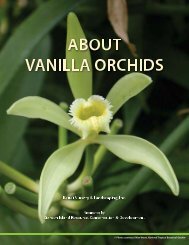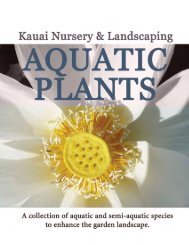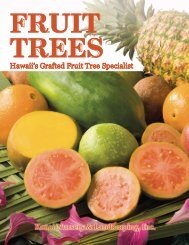Horticulture Digest - Kauai Nursery & Landscaping, Inc.
Horticulture Digest - Kauai Nursery & Landscaping, Inc.
Horticulture Digest - Kauai Nursery & Landscaping, Inc.
You also want an ePaper? Increase the reach of your titles
YUMPU automatically turns print PDFs into web optimized ePapers that Google loves.
BACKGROUND<br />
Native to Central and South America, the Anthurium includes over 1,000 species of climbing and herbaceous forms.<br />
Anthurium andreanum is one species which was introduced to Hawaii by way of London in 1889. This single<br />
species has become one of the major parents for the hybrid anthuriums you find cultivated in the islands today.<br />
BIOLOGY<br />
The anthurium is an aroid, the large Araceae family of plants. This family consists of at least 104 genera and 3,700<br />
species, and includes names you may be familiar with: Aglaonema, Alocasia, Caladium, Calla, Colocasia,<br />
Dieffenbachia, Epipremnum, Monstera, Philodendron, and Spathiphyllum.<br />
The aroids are distinguished by the combination of their spathe and spadix. The spathe is sometimes confused for<br />
being the true flower. In fact, the spathe is a modified bract that protects the spathe, a cone –shaped structure that in<br />
turn holds the true hermaphroditic flowers of the plant. For this presentation, however, we will use the common<br />
flower term to mean the spathe and spadix.<br />
What makes anthuriums unique among the aroids is the presence of a geniculum and collective vein on the leaf<br />
structure. The geniculum is the portion of tissue between the leaf blade and the leaf petiole. This acts as a joint<br />
(similar to your elbow) to allow the leaf to “turn” and orient itself for better light absorption. The collective vein is a<br />
specialized, submarginal vein found near the edge of the leaf.<br />
VARIETIES<br />
Anthurium species count exceeds 900. However, not all these species have the dramatic flowers that most people<br />
come to expect. Although there are a number of forms of anthuriums, the anthurium everyone is familiar with is a<br />
herbaceous perennial with clustered long–stemmed, heart- shaped flowers. These flowers come in a multitude of<br />
colors and shapes, and make excellent cuts for arrangements.<br />
POTTING<br />
Potted anthuriums prefer a coarse and well-drained media. Cinders, coconut husks, orchid bark, hapuu tree fern<br />
logs, peat moss, and perlite are common media components used by local growers. Although you may not find a<br />
ready-made mix to buy at your local store, you can create a basic mix using Sunshine Mix #4, and add in drainage<br />
amendments like coarse perlite or cinders. As you gain more experience with your growing habits, you can adjust<br />
your mix as needed.<br />
WATERING<br />
Anthuriums enjoy moisture. The natural habitat of most anthurium species is the tropical and sub-tropical rainforests<br />
of Central and South America. High humidity and moist media is highly preferred. However, over-watering can<br />
cause root damage and sudden yellowing of leaves. While anthuriums love moisture, they do not like saturated<br />
media. So make sure to monitor your watering. Light, frequent watering is preferred to heavy soakings. Don't<br />
forget a light misting on the leaves to help with the humidity.<br />
LIGHT<br />
Anthuriums love shade. Long exposure to direct sunlight will typically burn flowers and foliage. Give them a good<br />
shady area to grow. However, do not deprive them of all sunlight. Ideally 75-80% shade is best. Extremely low<br />
light levels can shut down flower production. If that happens, move your anthuriums to an area that receives more<br />
light and wait for flower production to resume.<br />
FERTILIZER<br />
Most growers use a slow time-release fertilizer on their plants. Anthurium roots are very sensitive to uncoated<br />
quick-release fertilizers, which can burn their sensitive roots. Even powder organic fertilizers can cause root burn.






